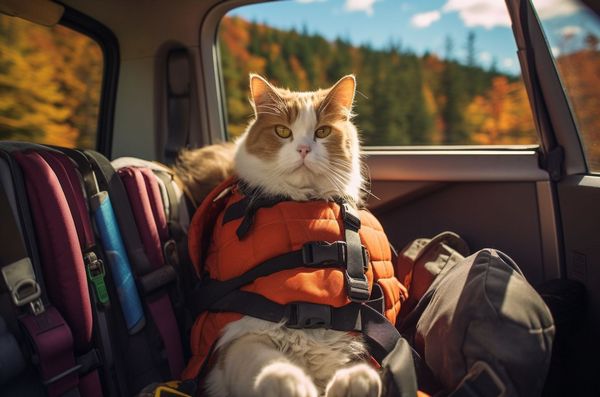Are you looking for tips on how to travel with cat in a car? Did you know that cats experience motion sickness when traveling long distances, so it is important to prepare in advance. In this blog post, we’ll look at how to safely and comfortably take your cat along on car trips.
From getting them used to the carrier and planning ahead for rest stops, here’s everything you need to know about taking Fido for a ride! Start gearing up: let’s hit the road with our furry friends!
How To Travel With Cat In A Car
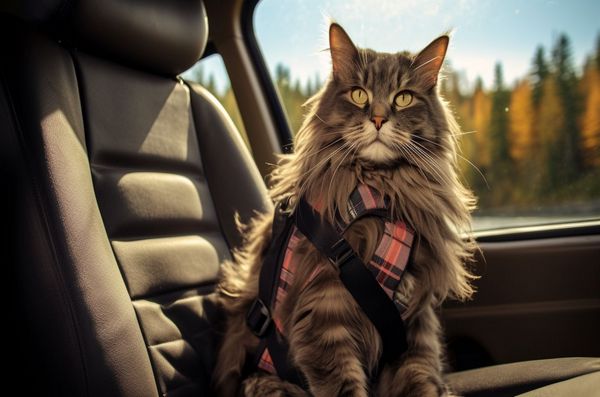
If you are traveling with a car in a car you have to take care of a few things. First, you have to do some early prep, i.e. before the day of the journey, Second on the trip day you should take some measures; then third and final precaution is when you are traveling. Let’s dive deep into all these 3 steps to ensure a smooth car journey.
General Tips on How To Travel with Cat in a Car
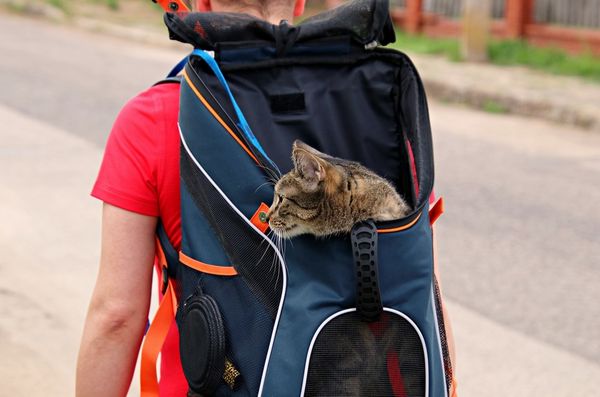
You have to follow these general tips before your trip so that on the final day you will be confident to take your cat on a long journey.
1. Choose a safe and comfortable cat carrier
When traveling with a cat, it is essential to choose a safe and comfortable cat carrier for your pet. Your cat will need the proper air circulation in order to stay relaxed on the journey.
Look for carriers that have wide panels made of mesh or plastic so they can get plenty of air flow as well as visibility. Avoid cardboard carriers since these are not durable enough and could lead to accidents like falls during the trip.
A soft sided carrier with adjustable shoulder straps can also offer great comfort for your furry friend as you hit the road. It is also important to make sure that your chosen carrier has an easy-to-clean design in case there are any unexpected messes along the way or if your cat gets sick during the travel.
2. Practice short drives with your cat
Driving your cat in the car can be a stressful experience for both of you. To ensure that your furry friend feels safe and secure, it’s best to practice short car rides prior to embarking on longer trips.
Short drives serve multiple purposes: they allow cats to become used to riding in vehicles, reduce their fear and anxiety associated with traveling in a car, strengthen the bond between pet and owner during each ride – all while getting them accustomed to any necessary grooming or medications.
Additionally, by taking shorter trips around town before hitting the open road, you can gradually distribute treats or rewards over several hours rather than overwhelming them with food at once.
3. Update your Cat’s ID tags
It’s essential to make sure your cat wears an ID tag with current contact information before traveling in a car.
Collars and harnesses can provide a convenient way to attach the ID tag that includes your address, name, phone number or email address so that if they wander away or get lost during the journey, anyone who finds them can quickly reach you.
Attaching an ID tag to their harness is the best option as it allows for some extra security and makes it easier for others to spot them from farther away. This will help ensure that if they happen escape at any point on their adventure then you’ll have higher chances of being reunited with them safely and swiftly!
4. Make reservations for cat-friendly accommodations
When traveling with a cat, it is essential to make sure that the accommodations chosen are cat-friendly. Although many hotels don’t accept animals, some have specially designated pet-friendly rooms or even entire buildings devoted to pet owners.
Hotels in particular offer a wide range of pet camping options for those travelling with cats – from dedicated budget motels to luxury lodges and Prime Suites.
By making reservations for suitable accommodation when visiting faraway places with your furry friend, you can guarantee that both of you will be as comfortable as possible during your trip together! This helps to ensure little mishaps like scratching felt carpets are avoided.
Preparing Your Cat for the Trip
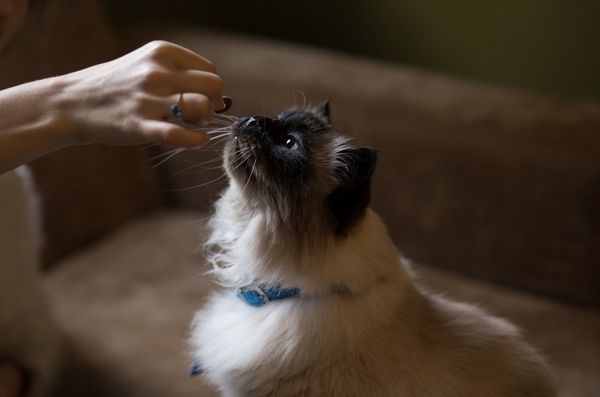
Make sure to plan ahead by providing your cat with a litter box, packing the essential foods and waters, and avoiding leaving your cat unattended in the car. Learning these strategies can help ensure that you and your feline companion have an enjoyable road trip!
1. Not feeding your cat before the trip
It is advisable not to feed your cat a few hours before the car ride, as it can increase the chances of them becoming car sick. If there is too much food in your cat’s stomach, their natural balance and equilibrium can be thrown off, leading to nausea and vomiting.
Additionally, leave plenty of fresh water available for your pet during the drive; dehydration gets rid of important electrolytes from their system which may also cause motion sickness because cats need constant hydration when travelling by car.
Keeping treats with you on the journey might encourage settling down and comfort if needed but ensure that they are only given in small amounts at regular intervals while travelling.
2. Administer any necessary medication
Before embarking on a long car ride with your cat, it is important to make sure they are comfortable and relaxed. In some cases, consulting with your veterinarian may be necessary in order to determine if medication is needed for the duration of the trip.
There are several over-the-counter medications available that can help reduce traveling anxiety in cats such as benzodiazepines or antihistamines. Additionally, stronger sedatives may be prescribed by a vet such as acepromazine which is known to calm cats during stressful situations like air travel.
It’s important to keep in mind that each cat responds differently to medications and side effects might include dizziness and drowsiness when travelling; therefore it’s important not to give too much of any one drug.
3. Exercise your cat before the trip
It is important to exercise your cat before a car trip in order to reduce their anxiousness and make the journey more enjoyable for both of you. Regular playtime can help tire them out, making it easier for them to relax on the road.
Taking regular walks outdoors or playing with toys indoors prior to leaving will encourage your cat’s natural instincts of running and jumping while allowing them plenty of time to explore and engage in physical activity.
Exercise will also aid digestion, as well as improve mood and behavior overall, ultimately leading to a happier traveling companion during the car ride. Involvement with interactive toys stimulating their senses by playing hide-and-seek can help keep cats active at home or when stopped along the way.
4. Encourage your cat to use the bathroom
Taking regular bathroom breaks for your cat is essential when you’re on the road. Planning pit stops along the route can ensure that your cat has opportunities to go to the bathroom and feel comfortable during travel.
Certain items can help your cat use the restroom while in a car, such as pee pads or portable litter boxes. Pee pads provide a surface area for cats to use, encouraging them to relieve themselves even if they’re not in a designated spot.
Portable litter boxes are also great for providing cats with their own little corner of comfort and familiarity while on long journeys–kind of like having their very own kitty toilet!
To make sure this setup works well for your pet, bring along some familiar-smelling litter from home so that they have something comforting and recognizable around them when it comes time do their business.
Final Tips on How To Travel with Cat in a Car
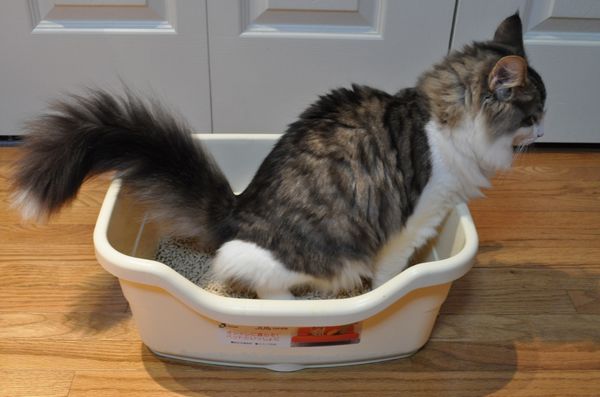
On the final day, i.e when you are travelling with your cat in a car then you have to take some precautions these are –
1. Providing a litter box
When traveling with a cat in a car, providing a litter box can help keep them safe and comfortable during the journey. A portable litter box is recommended as it offers cats their own space during the trip while keeping mess contained to one area.
The transportable litter boxes are typically sturdy enough for short or long journeys, creating a sense of familiarity and comfort for cats that may reduce stress levels. It is often advised to stick to the same brand of litter that they are used to in order to provide further familiarity throughout the trip.
To ensure no accidents happen, check on your cat’s bathroom habits regularly and be prepared with detangling sprays or wipes for those fur-covered excursions!
2. Using calming aids if needed
Cats can get very stressed when they travel in cars. To help keep them calm during the journey, it’s a good idea to use calming aids.
These products come in several forms such as pheromone diffusers or sprays, which simulate cat-specific scents and provide cats with an environment of familiarity and comfort; longer lasting collars that are infused with natural extracts; and CBD products containing hemp oil, rosemary, chamomile – all known for their ability to relax cats.
Products such as these may not be necessary for every trip but if your cat has shown signs of anxiety during car rides then sedatives (in consultation with a vet) can be given prior to the trip so they sleep comfortably throughout.
3. Packing food and water essentials
A long car trip with your furry companion means stocking up on the essentials. Make sure you pack enough high-quality dry kibble for your cat to eat along the way.
Sufficient water should be packed for both the cat and the traveler – remember that cats don’t like standing still water so always use fresh! Bring a few cans of wet food as well, if it’s part of your cat’s regular diet, just in case they’re not hungry for their kibble.
Finally, keep a supply of treats at hand in case there are times when you need to calm or reward your pet during the journey. Just make sure it doesn’t meddle with their diet routine!
4. Plan for pit stops
When traveling with a cat in a car, it is important to plan for regular pit stops. These provide an opportunity for your cat to use the litter box, have some water and stretch its legs.
Regular pit stops should be spaced out every 2-3 hours on longer trips to ensure your pet’s health and safety. Make sure you have plenty of supplies such as food, water and overnight accommodations ready beforehand in case there are unexpected delays along the way.
It also helps to bring along something from home that can make the trip more comfortable for your pet like a familiar blanket or toy so they don’t feel too unfamiliar during their travels.
5. Never leave your cat unattended in the car
Leaving your cat unattended in a car can be incredibly dangerous, even deadly. Animals are unable to regulate their body temperature like humans can, so when temperatures rise or dip outside the vehicle it is especially important that cats remain inside with someone, most preferably you.
If the weather is too hot for you take off a sweater and put on shades and still comfortable, then it is far too hot for your cat. Extremely hot climates can cause heat exhaustion or worse in pets who lack proper hydration and cool air.
On the other hand extreme colds as low as 26°F (or -3°C) can cause hypothermia if there’s no protection from drafts and inadequate coats or blankets – potentially leading to long term weariness across your pet’s whole body.
6. Bringing toys for entertainment
Traveling with a cat in car can be an enjoyable experience for both the pet owner and their furry companion. Toys can provide mental stimulation, comfort, and entertainment during long journeys.
When traveling with cats, it is important to select toys that are safe and suitable for them – interactive toys or soft toys are suitable alternatives. Before the journey, introducing these familiar objects from home will help to familiarize the cat earlier on.
They also offer familiarity when away from home as well as providing enrichment activities which reduce boredom throughout the trip. Rotating toys regularly will prevent your cat from becoming bored of its selection too quickly.
Avoid These To Travel With Cat In A Car
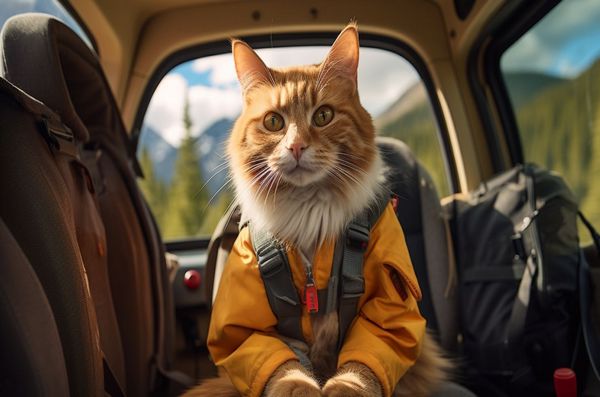
- Not preparing your cat or vehicle for the journey prior. Ensure to buy a large travel carrier, practice short drives with your cat and update their ID tags before leaving.
- Forgetting essential equipments such as litter box, calming aids, food & water essentials and toys. These items will help keep your furry companion safe and comfortable during the trip.
- Feeding your cat too close to departure time – cats should not eat within two hours of traveling in case they get car sick.
- Letting the cat roam free around the car cabin – doing so can distract you from driving safely while creating anxiety for the pet when sitting in unfamiliar surroundings.
- Leaving them alone inside a parked car – never leave your feline companion unattended in an unseen place as temperatures may rise rapidly leading to dire consequences on their health even if it is just temporary .
- Not taking regular breaks along the way – allowing enough time for rest stops allows you to give food, water and bathroom breaks necessary for both you and your cat’s comfort throughout long road trips
Conclusion
It is possible to travel with your cat in a car and have an enjoyable ride for everyone. With prior preparation, the right precautions, and some extra attention to the comfort of our cats during car trips, traveling together can be an incredibly rewarding experience for both you and your kitty.
Before taking off on a journey by car, make sure all safety measures are taken into account as well as making packing lists so that everything needed for the trip is accounted for (e.g food supplies).

